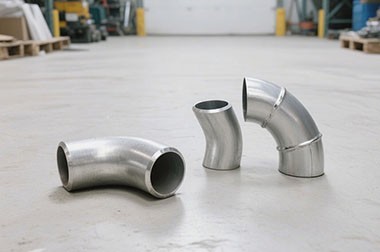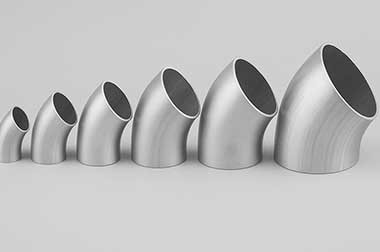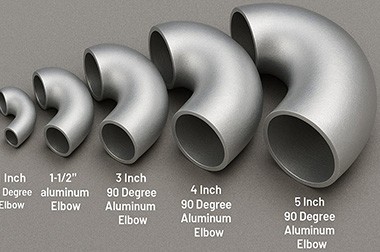Aluminum Elbow
We supply precision-engineered elbows in 45° to 180° angles. Perfect for lightweight piping systems. Competitive pricing and bulk order discounts. Get a quote today!
Marine elbows are indispensable key components in ship piping systems, mainly used to change the direction of pipelines and realize directional fluid transmission. Compared with ordinary elbows, marine elbows face harsher marine environmental challenges, and therefore have special requirements in material selection, design standards, and manufacturing processes.
Haomei Aluminum specializes in manufacturing various types of seamless aluminum bent pipes, seamless aluminum bends at any angle, welded aluminum elbows, aluminum tees (forgings), aluminum pipe caps, flanges, U-shaped bends with external threads, and aluminum sleeves. We can customize various bends and pipe caps according to user requirements and can manufacture based on user drawings. We hold a pressure pipeline equipment production license and are qualified to manufacture special equipment!
Haomei Aluminum's marine elbow products have been certified by major classification societies to ensure compliance with ship safety standards:
China Classification Society (CCS) standards, American Bureau of Shipping (ABS) standards, DNV GL (Norwegian classification society) standards, Lloyd's Register (LR) standards, Bureau Veritas (BV) standards
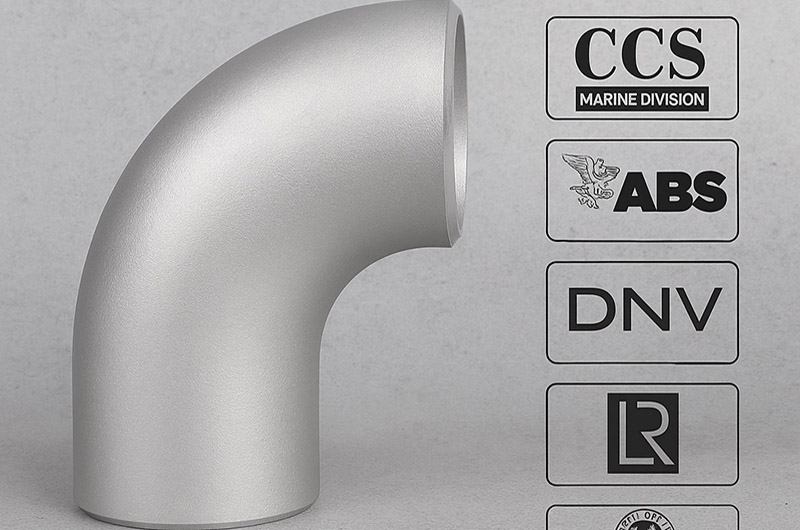
Marine aluminum alloy elbows mainly use 5000 series and 6000 series aluminum alloys, such as 5052, 5083, 5086, and 6061. 5083 aluminum alloy has excellent seawater corrosion resistance and medium strength, making it an ideal material for marine aluminum elbows. Aluminum elbows are widely used in ship systems such as ballast water systems, cooling systems, and fuel systems.
We provide precisely designed elbows ranging from 45° to 180°, making them an ideal choice for lightweight piping systems. Competitive prices, discounts available for bulk orders. Get a quote now!
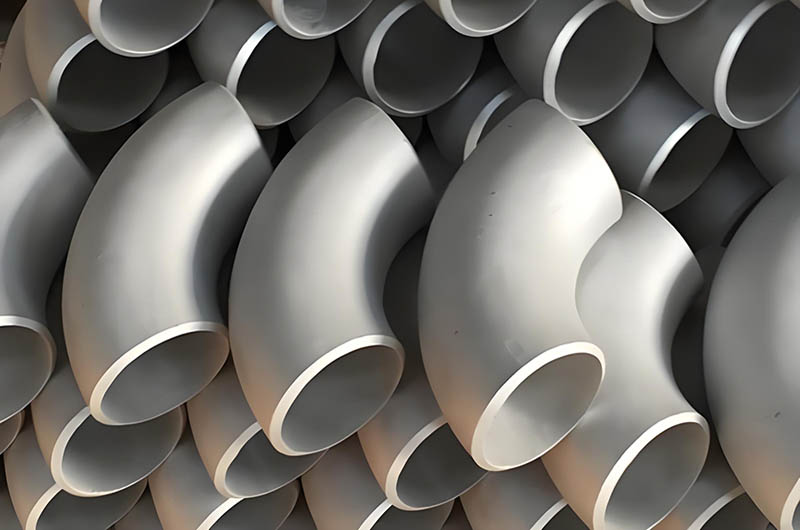
Specification of Haomei Aluminium Elbow Products Detial
| Aluminium Pipe Fittings | Form | Seamless and welded |
| Fittings Shape | Elbows, Tees, Reducers, Caps,Nipples | |
| Size Range | 1/2''-24'' | |
| Material | 1000-7000 Series | |
| Wall Thickness | SCH10--SCH160, STD--XXS | |
| Ends Type | Butt weld | |
| Surface treatment | Anodized | |
| Standard | ANSI B16.9, ASTM B361 |
Common Types of Aluminum Elbows
Elbows with Different Angles (e.g., 45 degrees, 90 degrees)
| Type of Aluminum Elbow | Aluminum Elbow Image | Description |
| 90-Degree Aluminum Elbow |
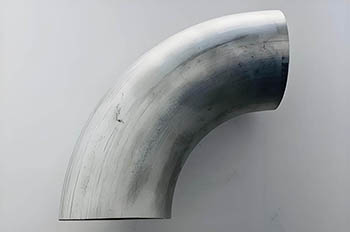
|
The 90-degree aluminum elbow, also known as a right-angle elbow, is one of the most common connectors in piping systems, allowing fluids or gases to change direction at a 90-degree angle. It is widely used in water supply, drainage, ventilation, chemical processing, food processing, and aerospace industries. Due to the excellent corrosion resistance and lightweight, high-strength properties of aluminum alloy materials, the 90-degree aluminum elbow is particularly suitable for applications requiring both durability and reduced weight, such as aircraft fuel lines, marine engineering, and high-end manufacturing. |
| 45-Degree Aluminum Elbow |
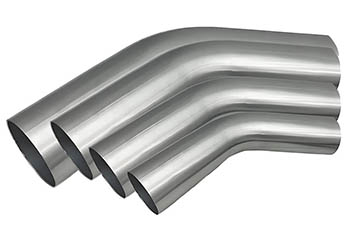
|
The 45-degree aluminum elbow is designed to enable smooth transitions of fluid within pipelines, primarily to reduce flow resistance, minimize energy loss, and decrease turbulence. Its gradual turning design makes it suitable for building pipelines, oil and gas transportation systems, air conditioning and refrigeration equipment, and precision instrument piping. Thanks to its excellent corrosion resistance, ease of processing, and high strength, the aluminum alloy 45-degree elbow is widely used in lightweight, high-efficiency industrial piping systems, such as aerospace pipelines, automotive exhaust systems, and marine hydraulic pipelines. |
| 180-Degree Aluminum Elbow |
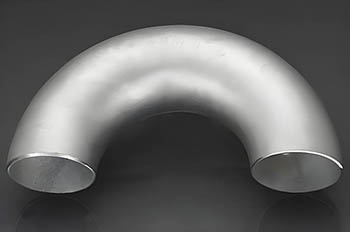
|
The 180-degree aluminum elbow, also known as a U-shaped elbow, is mainly used in applications requiring fluid return flow or compact pipeline layouts, such as heat exchange equipment, chemical circulation systems, and heating/cooling systems. Its aluminum alloy material not only provides excellent thermal conductivity and corrosion resistance but also significantly reduces the overall weight of the piping system, enhancing efficiency and durability. The 180-degree aluminum elbow is widely applied in air conditioning and refrigeration equipment, automotive cooling circuits, marine heat exchange systems, and aerospace piping systems to meet high-performance and long-life requirements. |
In addition to these standard-angle elbows, there are also special-angle elbows designed to meet specific engineering requirements.
Classification by Manufacturing Process
Seamless Aluminum Elbows
- Seamless aluminum elbows are the most common type of marine elbows. They feature no weld seams, high strength, and excellent sealing. The main manufacturing processes include hot pushing, stamping, forging, and bending forming.
- Advantages of seamless aluminum elbows include resistance to corrosion, pitting, rust, and wear. They are lightweight—only about one-tenth the weight of steel pipes—significantly reducing transportation costs and installation load.
Welded Aluminum Elbows
- Welded aluminum elbows are formed by welding two or more parts together. Based on weld seam type and manufacturing process, they are mainly divided into long-radius welded elbows (LG type) and short-radius welded elbows (SG type).
- Advantages of welded aluminum elbows include the ability to manufacture large-diameter elbows and relatively lower cost. However, weld quality greatly affects elbow performance, requiring strict control over welding processes and quality.
Forged Aluminum Elbows
- Forged aluminum elbows are produced through forging processes and feature dense structure, high strength, and good toughness. The main manufacturing steps include preheating treatment, forging formation, cooling, heat treatment, and machining.
- Advantages of forged aluminum elbows include high material utilization, dense microstructure, high strength and toughness. They are suitable for high-pressure and impact load environments. However, forging processes are complex and costly.
| Performance Characteristics | Seamless Aluminum Elbow | Welded Aluminum Elbow | Forged Aluminum Elbow |
| Manufacturing Process | Hot pushing, stamping, extrusion, etc. | Cutting, assembling, welding | Forging, machining |
| Strength | High | Depends on weld quality | Highest |
| Corrosion Resistance | Good | Risk of corrosion at weld seams | Good |
| Size Range | Small to medium diameters | Large diameters | Small to medium diameters |
| Cost | Medium | Lower | Higher |
| Application Scenarios | Medium and high pressure piping systems | Low pressure large-diameter piping systems | High pressure, impact load scenarios |
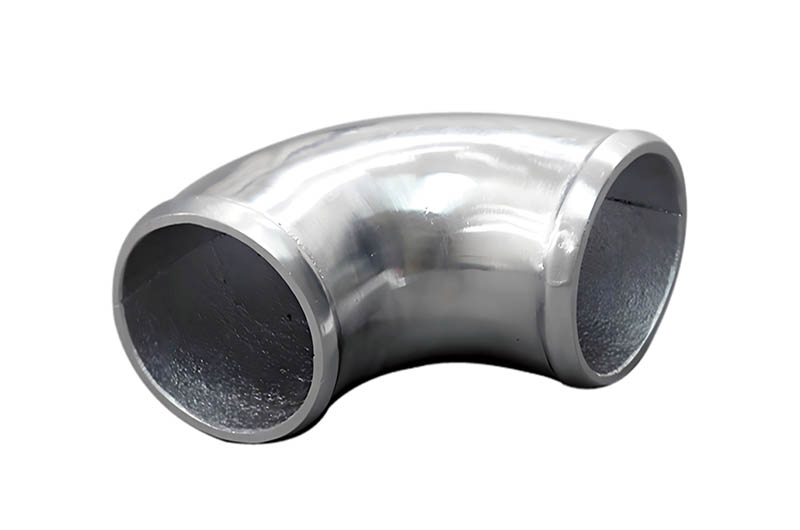
Cast Aluminum Elbow 90 Degree Pipe
Aluminum Elbow Wall Thickness Classification
| Type of Elbow | Description |
| Standard Wall Thickness Aluminum Elbow (Schedule 40) | Standard wall thickness aluminum elbows (Schedule 40) are thicker and more durable compared to conventional thin-wall elbows. They are suitable for high-pressure environments or situations with greater impact forces. Their increased wall thickness provides higher structural strength, helping to withstand greater pressure and external impacts, ensuring pipeline system stability. Standard wall thickness elbows are widely used in industrial pipelines, water supply systems, and other applications requiring high durability. |
| Thin-Wall Aluminum Elbow | Thin-wall aluminum elbows are typically used in pipeline systems with relatively low pressure requirements and high flow demands. Their thin-wall design makes them lighter and allows for smooth, flush connections using butt-weld fittings. Due to their reduced wall thickness, they maximize flow capacity and minimize fluid resistance within the pipeline. Thin-wall aluminum elbows are commonly used in environments where high pressure or extreme external forces are not required, such as general household piping and low-pressure industrial applications. |
| Thick-Wall Aluminum Elbow | Thick-wall aluminum elbows have a greater wall thickness than standard elbows, offering higher strength and better durability. They are typically used in applications that must withstand greater pressure and mechanical stress. Their thick-wall design enables them to handle harsh working environments, including high-pressure pipeline systems and areas expected to experience significant impact. These elbows are widely applied in petrochemical, energy, and steel industries, providing enhanced safety and reliability for high-pressure or high-load pipeline systems. |
Aluminum Elbow Pressure Rating Classification
| Elbow Type | Description |
| Low-Pressure Aluminum Elbow | Low-pressure aluminum elbows are mainly used in environments with relatively low flow rates. They are designed to be lightweight and cost-effective. Due to their thin walls, they are suitable for applications that do not require high pressure, such as low-pressure water piping systems and ventilation ducts. Low-pressure aluminum elbows provide excellent fluid flow capability and effectively reduce flow resistance, making them widely used in household, light industry, and simple piping systems. |
| Medium-Pressure Aluminum Elbow | Medium-pressure aluminum elbows are suitable for medium-pressure piping systems. Compared to low-pressure types, they offer higher strength and durability, allowing them to withstand greater working pressures, making them an ideal choice for general industrial applications. Medium-pressure aluminum elbows are commonly used in water supply, HVAC, and chemical industry pipelines, ensuring reliable and secure pipe connections while maintaining smooth fluid flow. |
| High-Pressure (3000 Class) Aluminum Elbow | High-pressure aluminum elbows (3000 class) are designed for the highest level of pressure resistance. They are commonly used in demanding environments such as oil and gas transmission systems, air compression systems, and other high-requirement industrial applications. These elbows feature thick-wall designs that effectively resist stress under high pressure, ensuring the stability of the system. High-pressure aluminum elbows are widely used in oil and gas pipelines and high-pressure equipment piping systems, offering superior safety and reliability. |
Aluminum Elbow Connection Type Classification
| Elbow Type | Description |
| Welded Aluminum Elbow | Welded aluminum elbows are suitable for high-pressure and high-temperature environments, often used in applications with stringent technical standards and connection strength requirements. The welding method provides a high-strength connection, making it ideal for pipeline systems that need to withstand extreme conditions, such as petrochemical, power generation, steam, and natural gas transmission systems. The installation of welded aluminum elbows requires professional skills to ensure joint sealing and pressure resistance. They are typically used in high-temperature or high-pressure industrial environments. |
| Threaded Aluminum Elbow | Threaded aluminum elbows are suitable for low-pressure, small-scale piping systems and are commonly used in simple connection types that are easy to maintain. These elbows feature threaded connections, making them easy to install and cost-effective, ideal for household plumbing, light industry, and low-pressure fluid transport systems. Due to their simple structure, maintenance and disassembly are also easy. Threaded aluminum elbows are a common choice for small-scale piping systems. |
| Flanged Aluminum Elbow | Flanged aluminum elbows are suitable for large-diameter, high-pressure piping systems, providing a very secure connection. Flange connections offer high strength and sealing capability, making them ideal for applications requiring frequent disassembly and maintenance. However, installing flanged aluminum elbows is more complex and costly. They are typically used in large industrial piping systems requiring high strength and reliability, such as in the chemical, energy, and oil and gas industries. |
| Socket-Weld Aluminum Elbow | Socket-weld aluminum elbows do not require precise alignment of the pipes during installation. The pipes can slide into the fitting and be welded, providing greater installation flexibility. These fittings are typically made of aluminum, offering lightweight and corrosion-resistant properties. They are suitable for piping systems requiring flexible installation and capable of withstanding medium to low pressure. Socket-weld aluminum elbows are widely used in cooling, water supply, ventilation, and similar systems, making them an ideal choice for applications requiring quick installation and disassembly. |
How to Choose the Right Aluminum Elbow Angle?
- Prioritize determining the angle to reduce costs and project duration.
- Choose 90° or 45° angles in space-constrained areas to balance functionality and compactness.
- Pay attention to material processing to avoid excessive bending that may damage the aluminum material.
- For critical systems, conduct simulation verification to ensure the angle meets performance requirements.
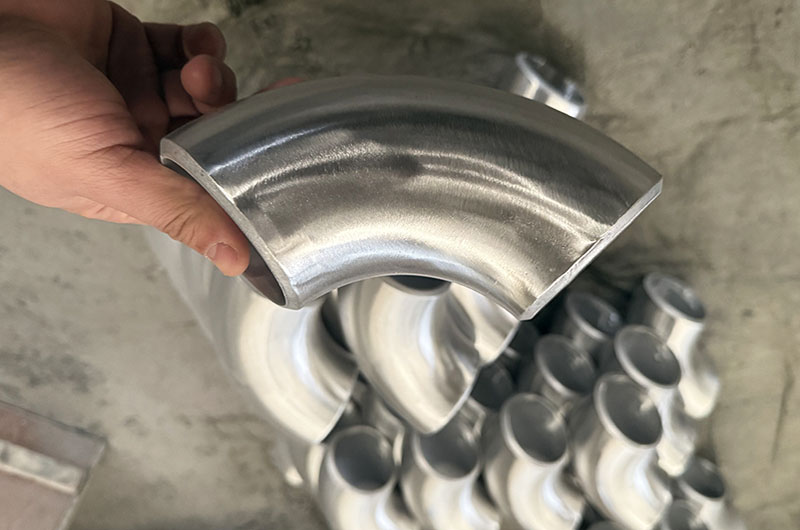
Common sizes of HC aluminum elbow
Common sizes of HC Aluminum elbow (45˚)
| NPS | Insulation thickness | ||||||
| 1" | 1 1/2" | 2" | 2 1/2" | 3" | 3 1/2" | 4" | |
| 1/2" | #1 | #3 | #5 | #7 | #8 | #9 | #10 |
| 3/4" | #1 | #3 | #5 | #7 | #8 | #9 | #10 |
| 1" | #2 | #4 | #6 | #7 | #8 | #9 | #10 |
| 1 1/4" | #2 | #5 | #6 | #7 | #8 | #9 | #10 |
| 1 1/2" | #3 | #5 | #7 | #8 | #9 | #10 | #11 |
| 2" | #4 | #6 | #7 | #8 | #9 | #10 | #11 |
| 2 1/2" | #5 | #7 | #8 | #9 | #10 | #11 | #12 |
| 3" | #6 | #7 | #8 | #9 | #10 | #11 | #12 |
| 4" | #7 | #8 | #9 | #10 | #11 | #12 | #13 |
| 6" | #9 | #10 | #11 | #12 | #13 | #14 | #15 |
| 8" | #11 | #12 | #13 | #14 | #15 | #16 | #17 |
| 10" | #13 | #14 | #15 | #16 | #17 | #18 | #19 |
| 12" | #15 | #16 | #17 | #18 | #19 | #20 | #21 |
| 14" | #16 | #17 | #18 | #19 | #20 | #21 | #22 |
| 16" | #18 | #19 | #20 | #21 | #22 | #23 | #24 |
| 18" | #20 | #21 | #22 | #23 | #24 | #25 | #26 |
| 20" | #22 | #23 | #24 | #25 | #26 | #27 | #28 |
| 24" | #26 | #27 | #28 | #29 | #30 | ||
Common sizes of HC Aluminum elbow (90˚)
| NPS | Insulation thickness | ||||||||||||||||||
| 1/2" | 1" | 1.5" | 2" | 2.5" | 3" | 3.5" | 4" | 4.33" | 4.72" | 5.12" | 5.51" | 5.91" | 6.3" | 6.7" | 7.09" | 7.49" | 7.87" | 8.46" | |
| 1/2" | #1 | #2 | #5 | #8 | #12 | #23 | #15 | #25 | |||||||||||
| 3/4" | #2 | #5 | #8 | #12 | #23 | #15 | #25 | ||||||||||||
| 1" | N/A | #3 | #6 | #11 | #12 | #23 | #15 | #25 | |||||||||||
| 1-1/4" | N/A | #3 | #9 | #11 | #12 | #23 | #15 | #25 | |||||||||||
| 1-1/21' | N/A | #4 | #9 | #18 | #23 | #15 | #25 | #26 | |||||||||||
| 2" | N/A | #7 | #10 | #18 | #20 | #24 | #25 | #26 | |||||||||||
| 2-1/2" | N/A | #13 | #16 | #20 | #24 | #25 | #26 | #31 | #58 | #59 | #S11 | #S12 | #S15 | #S16 | #S17 | ||||
| 3" | N/A | #14 | #19 | #22 | #24 | #25 | #26 | #31 | #59 | #S11 | #S12 | #S13 | #S15 | #S16 | #S17 | ||||
| 3-1/2" | N/A | #17 | #21 | #27 | #30 | #33 | #31 | #34 | #60 | #S11 | #S12 | #S13 | #S16 | #S17 | #S24 | #S25 | |||
| 4" | N/A | #17 | #21 | #27 | #30 | #33 | #31 | #34 | #S12 | #S13 | #S18 | #S24 | #S25 | ||||||
| 4-1/2" | N/A | #28 | #27 | #30 | #38 | #31 | #34 | #40 | #S4 | #S13 | #S14 | #S22 | #S19 | #S20 | #S24 | #S25 | #S26 | ||
| 5" | N/A | #28 | #29 | #36 | #38 | #39 | #34 | #40 | #S4 | #S6 | #S14 | #S22 | #S19 | #S20 | #S21 | #S25 | #S26 | #S32 | |
| 6" | N/A | #32 | #35 | #37 | #39 | #44 | #45 | #57 | #S6 | #S14 | #S22 | #S19 | #S20 | #S21 | #S25 | #S26 | #S32 | #S33 | |
| 7" | N/A | #35 | #37 | #39 | #44 | #45 | #57 | #52 | #S22 | #S23 | #S20 | #S29 | #S30 | #S31 | #S32 | #S33 | |||
| 8" | N/A | #41 | #42 | #43 | #47 | #49 | #52 | #53 | #S22 | #S23 | #S28 | #S29 | #S30 | #S32 | #S33 | ||||
| 9" | N/A | #42 | #43 | #47 | #49 | #52 | #53 | #S1 | #S23 | #S27 | #S28 | #S29 | #S33 | ||||||
| 10" | N/A | #46 | #50 | #51 | #55 | #54 | #S1 | #S3 | #S27 | #S28 | #S29 | #S38 | #S39 | #S40 | #S41 | ||||
| 111' | N/A | #50 | #51 | #55 | #56 | #S1 | #S3 | N/A | #S28 | #S29 | #S35 | #S39 | #S40 | ||||||
| 12" | N/A | #48 | #55 | #56 | #S1 | #S3 | #S5 | #S28 | #S34 | #S35 | #S36 | #S37 | #S40 | #S51 | #S52 | ||||
| 14" | N/A | N/A | N/A | S1 | #S3 | #S5 | #S7 | S34 | #S35 | #S36 | #S37 | #S44 | #S50 | #S51 | #S52 | ||||
| 15" | N/A | N/A | #S2 | #S3 | #S5 | #S7 | #S9 | N/A | #S42 | #S43 | #S44 | #S45 | #S50 | #S51 | #S52 | ||||
| 16" | N/A | S2 | #S4 | #S5 | #S7 | #S9 | #S10 | #S42 | #S43 | #S44 | #S50 | #S51 | #S52 | #S54 | |||||
| 17" | N/A | N/A | N/A | N/A | #S9 | #S10 | #S42 | #S43 | #S44 | #S47 | #S48 | #S53 | #S54 | #S55 | |||||
| 18" | N/A | #S5 | #S8 | #S9 | #S10 | N/A | N/A | N/A | #S47 | #S48 | #S49 | #S53 | #S54 | #S55 | |||||
| 20" | N/A | #S8 | #S9 | #S10 | N/A | N/A | #S46 | #S47 | #S48 | #S53 | #S54 | #S55 | |||||||
| Note | #S is 4 pcs/set, others are 2 ha | ves. | |||||||||||||||||
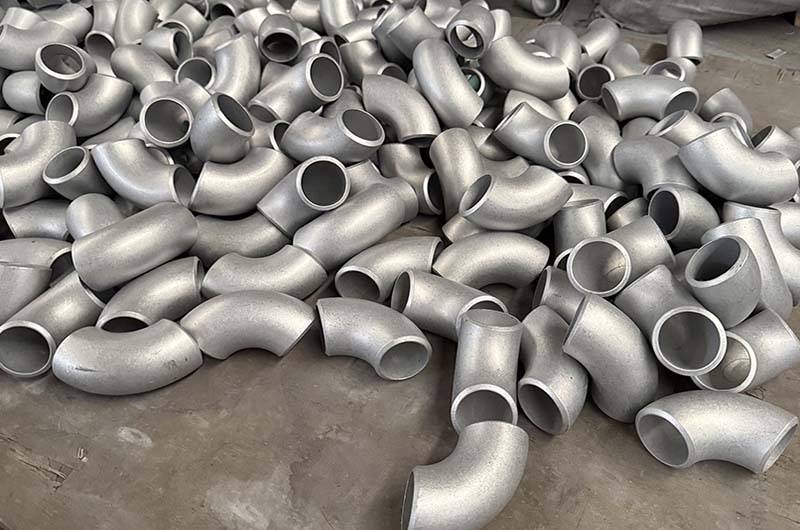
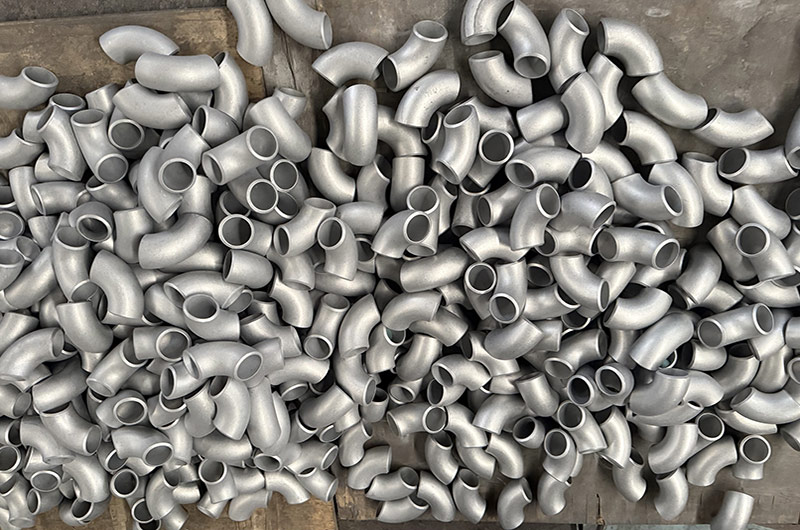
Material Properties and Selection of Marine Aluminum Elbows
Common Aluminum Alloys for Marine Elbows
5083 Aluminum Elbow
- 5083 is an Al-Mg series alloy containing magnesium (4.0-4.9%), manganese (0.4-1%), chromium (0.05-0.25%), etc. It has excellent corrosion resistance, especially against seawater and atmospheric corrosion; good weldability, suitable for various welding methods.
- Applications: shipbuilding, marine engineering, pressure vessels, especially suitable for ballast water systems, cooling systems, and seawater piping systems on ships.
6061 Aluminum Elbow
- 6061 is an Al-Mg-Si series alloy containing magnesium (0.8-1.2%), silicon (0.4-0.8%), copper (0.15-0.4%), etc. It features good strength and toughness, as well as good corrosion resistance and weldability; excellent machinability, suitable for various cold and hot processing methods.
- Applications: ships, automobiles, machinery manufacturing, etc. On ships, it is often used for cantilevers, bridge supports, and other parts, and can also be used to make elbows requiring medium strength and good corrosion resistance.
Other Aluminum Alloy Elbows
- 5086 Aluminum Alloy: an Al-Mg alloy with good ductility and corrosion resistance, and excellent weldability. Commonly used for hull bottoms and transoms where good corrosion resistance and formability are required.
- 7075 Aluminum Alloy: an Al-Zn-Mg-Cu series alloy with high strength and good wear resistance, but relatively poor stress corrosion resistance. Mainly used for high-strength and wear-resistant parts such as anchor chains.
- 1060 Pure Aluminum: purity over 99.6%, offering excellent electrical conductivity, thermal conductivity, and corrosion resistance, though with lower strength. Commonly used for elbows requiring good corrosion resistance but not high strength.
Principles for Selecting Marine Aluminum Elbow Materials
When selecting materials for marine aluminum elbows, factors such as usage environment, mechanical performance requirements, processing requirements, cost, service life, and environmental impact should be comprehensively considered.
- Seawater systems: 5083 aluminum alloy is preferred due to its excellent seawater corrosion resistance.
- Freshwater systems: 5083 or 6061 aluminum alloys can be used, or lower-cost pure aluminum.
- High-pressure systems: 5083 or 6061 aluminum alloys are preferred to ensure sufficient strength.
- Welded applications: 5083 aluminum alloy is preferred for its good weldability.

6061-T6 90° Aluminum Elbow
Advantages of Aluminum Elbow over Other Materials
| Comparison Advantage | Description |
| Aluminum elbows are more cost-effective compared to stainless steel elbows | Aluminum elbows offer advantages in terms of manufacturing and material costs compared to stainless steel elbows. Due to the low density and excellent machinability of aluminum, its raw material price and production process costs are generally lower than those of stainless steel. Additionally, aluminum elbows often do not require extra surface treatments such as passivation or coatings, further reducing overall costs. Therefore, in projects where moderate corrosion resistance is sufficient and budget constraints are a concern, aluminum elbows provide a more economical choice, such as in HVAC (heating, ventilation, and air conditioning), lightweight structural piping, and marine systems. |
| Aluminum elbows have superior corrosion resistance compared to carbon steel elbows | Aluminum elbows exhibit significantly better corrosion resistance than carbon steel elbows, especially in humid, marine, and chemical environments. Aluminum naturally forms a dense oxide layer in the air, which protects it from oxidation and corrosion, whereas carbon steel requires additional coatings or galvanization to prevent rust. Moreover, aluminum alloy elbows are more stable when in contact with chemicals, making them widely used in marine engineering, chemical pipelines, and food processing equipment that require long-term corrosion resistance. |
| Aluminum elbows are easier to handle and install due to their lightweight nature | Aluminum elbows have a density of approximately one-third that of steel, making them significantly lighter during transportation, handling, and installation. This weight advantage not only reduces construction difficulty but also lowers labor and equipment costs, improving overall efficiency. In applications requiring frequent maintenance or pipe replacements, such as aerospace, automotive exhaust systems, and mobile equipment pipelines, aluminum elbows are an ideal choice due to their lightweight properties. |
Surface Treatment of Aluminum Elbow
Surface Treatment: Hard anodized film thickness of 50-80μm, hardness HV400, salt spray test duration of over 1000 hours.
- Anodizing: Enhances corrosion resistance and allows color customization.
- Powder Coating: Increases durability and provides an attractive finish.
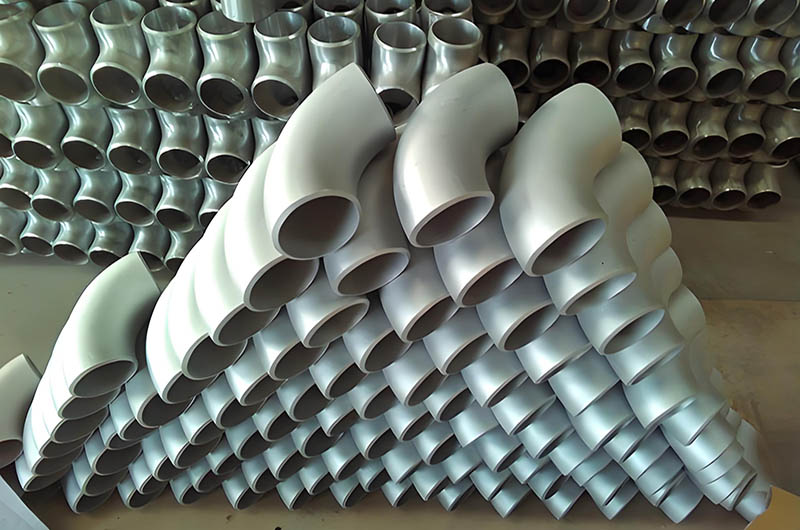
Aluminum Pipe Elbow
Applications of Marine Aluminum Elbows in Ship Systems
Application of Marine Aluminum Elbows in Ballast Water Systems
The ballast water system is one of the important systems on a ship. Its main function is to adjust the ship's draft, trim, heel, and stability by filling or discharging ballast water. Aluminum elbows offer advantages such as good corrosion resistance, light weight, and good weldability in ballast water systems.
Aluminum elbows are used at turning points of ballast water pipelines, connections to ballast tanks, ballast water treatment system connections, and overboard discharge systems.
Application of Marine Aluminum Elbows in Cooling Systems
The main function of a ship's cooling system is to remove the heat generated by the engine and other equipment during operation through circulating coolant. Aluminum elbows offer advantages such as good thermal conductivity, corrosion resistance, and light weight in cooling systems.
Aluminum elbows are used to connect engine cooling water pipelines, cooler connections, heat exchanger connections, cooling water pump connections, and expansion tank connections.
Application of Marine Aluminum Elbows in Fuel Systems
The main function of the ship’s fuel system is to store, transport, and supply fuel, providing power to the main engine and auxiliary engines. Aluminum elbows have advantages such as light weight, good corrosion resistance, and good processability in fuel systems.
Aluminum elbows are used to connect fuel delivery pipelines, fuel tank connections, fuel pump connections, fuel filter connections, and fuel heater connections.
Application of Marine Aluminum Elbows in Other Ship Systems
Water Supply System
Marine aluminum elbows are used to connect freshwater storage tanks, water pumps, filters, and water-using equipment to realize the delivery and distribution of freshwater; and to connect seawater pumps, seawater coolers, and other seawater-use equipment to realize the delivery and utilization of seawater.
Ventilation System
Marine aluminum elbows are used to connect fans, air handling units, and air supply outlets to deliver and distribute fresh air; and to connect exhaust outlets, fans, and exhaust stacks to discharge contaminated air.
Firefighting System
Marine aluminum elbows are used to connect fire pumps, fire hoses, and fire hydrants to transport and distribute firefighting water; and to connect foam generators, foam liquid tanks, and foam spraying equipment to deliver and spray foam.
Hydraulic System
Marine aluminum elbows are used to connect hydraulic pumps, hydraulic valves, and hydraulic actuators to transport and control hydraulic oil.
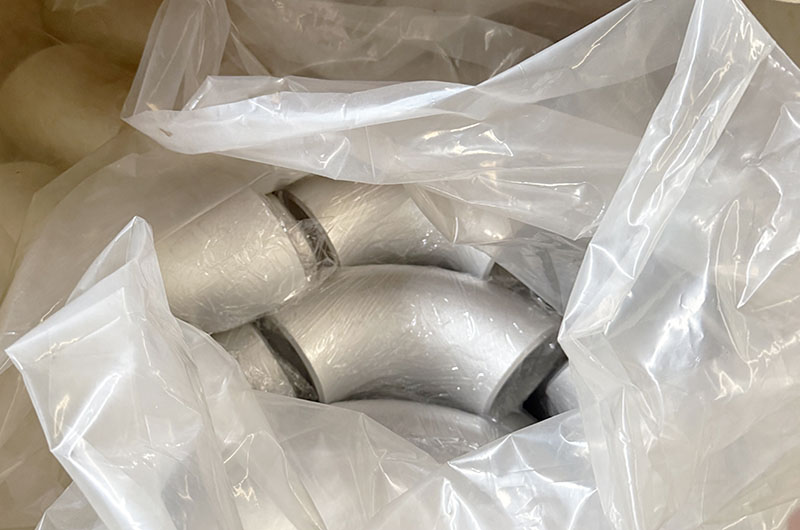
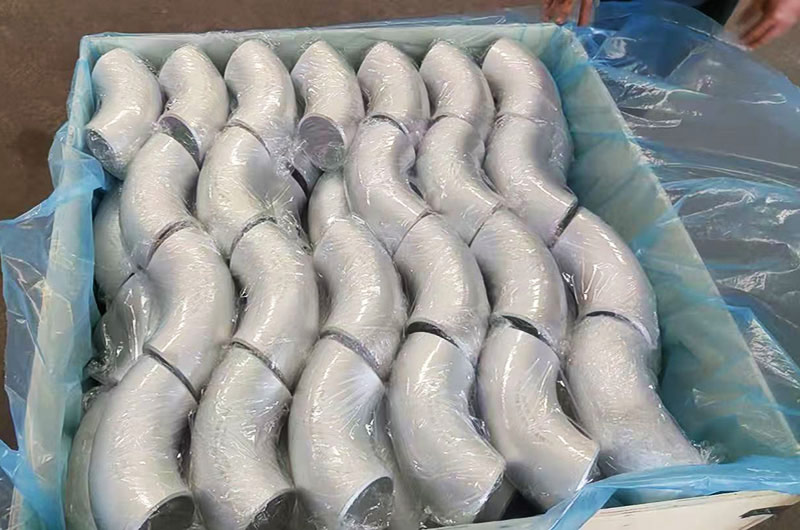
Content you may be interested in
-
As a trusted aluminum fittings supplier, HC Aluminum offers a wide range of 4 Aluminum Elbow options in mainstream specifications, commonly including 45°, 90°, and 180°.
-
We offer marine-grade 45-degree aluminum elbows in a range of standard sizes including 2 inch, 3 inch, 4 inch, 5 inch, 6 inch, along with customized options such as Cast Aluminum 45 Degree Elbow.
-
Our marine-grade 90-degree aluminum elbow products are certified by multiple international classification societies (DNV/ABS/CCS/BV), ensuring compliance with the stringent requirements of shipbuilding and marine engineering.

